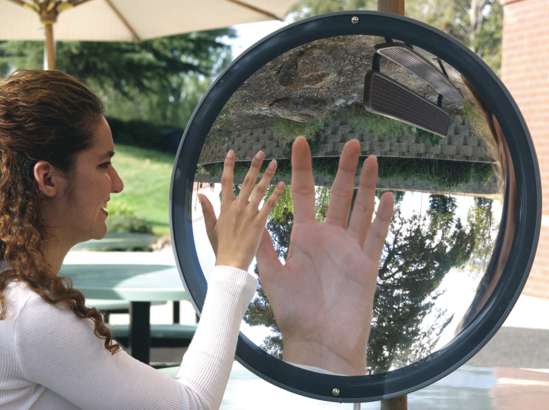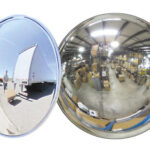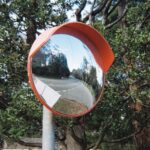Previously ray diagrams were constructed in order to determine the location, size, orientation, and type of image formed by concave mirrors. The ray diagram constructed earlier for a convex mirror revealed that the image of the object was virtual, upright, reduced in size and located behind the mirror. But will these always be the characteristics of an image produced by a convex mirror? Can convex mirrors ever produce real images? Inverted images? Magnified Images? To answer these questions, we will look at three different ray diagrams for objects positioned at different locations along the principal axis. The diagrams are shown below.

The diagrams above show that in each case, the image is
· located behind the convex mirror
· a virtual image
· an upright image
· reduced in size (i.e., smaller than the object)
Unlike concave mirrors, convex mirrors always produce images that share these characteristics. The location of the object does not affect the characteristics of the image. As such, the characteristics of the images formed by convex mirrors are easily predictable.
Another characteristic of the images of objects formed by convex mirrors pertains to how a variation in object distance affects the image distance and size. The diagram below shows seven different object locations (drawn and labeled in red) and their corresponding image locations (drawn and labeled in blue).

The diagram shows that as the object distance is decreased, the image distance is decreased and the image size is increased. So as an object approaches the mirror, its virtual image on the opposite side of the mirror approaches the mirror as well; and at the same time, the image is becoming larger.
Check Your Understanding
The following questions pertain to the image characteristics of all types of mirrors discussed in this unit – plane mirrors, concave mirrors, and convex mirrors. Use your understanding of the object-image relationships for these three types of mirrors to answer the questions.
The diagram below shows a spherical surface that is silvered on both sides. Thus, the surface serves as double-sided mirror, with one of the sides being the concave and one being the convex side. The principal axis, focal point, and center of curvature are shown. The region on both sides of the mirror is divided into eight sections (labeled M, N, P, Q, R, S, T, and W). Five objects (labeled 1, 2, 3, 4, and 5) are shown at various locations about the double-sided mirror. Use the diagram to answer the questions #1-6.

1. The image of object 1 would be located in section ______.
| M | N | P | Q | R | S | T | W |
See Answer

Answer: S
When the object is located beyond C, the image is located between C and F and is inverted.
2. The image of object 2 would be located in section ______.
| M | N | P | Q | R | S | T | W |
See Answer

Answer: R
When the object is located between C and F, the image is located beyond C and is inverted. So if the object is positioned above the principal axis, then the image is positioned below the principal axis.
3. The image of object 3 would be located in section ______.
| M | N | P | Q | R | S | T | W |
See Answer

Answer: P
The object is on the convex side of the mirror so the image is located on the other side of the mirror and is upright.
4. The image of object 4 would be located in section ______.
| M | N | P | Q | R | S | T | W |
See Answer

Answer: M
When the object is located betwee C and F, the image is located beyond C and is inverted. So if the object is positioned below the principal axis, then the image is positioned above the principal axis.
5. The image of object 5 would be located in section ______.
| M | N | P | Q | R | S | T | W |
See Answer

Answer: W
The object is located in front of F for a concave mirror, so the image is upright, virtual and on the opposite side of the mirror. So if the object is positioned below the principal axis, the image is positioned below the principal axis.
6. The double-sided mirror would cause virtual image to be formed of objects ________.
| a. 1, 2, and 4 | b. 1, 2, and 3 | c. 3 and 5 | d. 4 and 5 | e. 3 only |
See Answer

Answer: Objects 3 and 5
Virtual images are always formed by convex mirrors and are formed by concave mirrors when the object is placed in front of F.

7. How can a plane mirror, concave mirror, and/or convex mirror be used to produce an image that has the same size as the object?
See Answer

Plane mirrors will always do this.
Concave mirrors will do this when the object is at C or when the object is right on the mirror surface.
Convex mirrors will only do this when the object is right on the mirror surface.
8. How can a plane mirror, concave mirror, and/or convex mirror be used to produce an upright image?
See Answer

Plane mirrors and convex mirrors will always produce an upright image. A concave mirror will only produce an upright image if the object is located in front of the focal point.
9. How can a plane mirror, concave mirror, and/or convex mirror be used to produce a real image?
See Answer

Plane mirrors and convex mirrors only produce virtual images. Only a concave mirror is capable of producing a real image and this only occurs if the object is located a distance greater than a focal length from the mirror’s surface.
10. The image of an object is found to be upright and reduced in size. What type of mirror is used to produce such an image?
See Answer

Only a convex mirror could produce such an image. The upright images produced by concave mirrors (when object is in front of F) are magnified images. And the upright images produced by plane mirrors have the same size as the object.


